Last year we acquired a new resource called Anatomy TV. We wanted to raise awareness of this new resource and encourage usage so we devised a marketing plan to help us do this. We decided to focus on what the user could achieve by using this resource, rather than just simply telling them they have access to it. The message we wanted to convey was “Improve your knowledge of anatomy”. We thought this would appeal to staff wanting to update their existing knowledge and also to students needing to learn anatomy for their studies.
The Marketing Plan
We started by having some brain storming sessions on how we could go about marketing Anatomy TV and we came up with the following plan:
- Library displays
- Email signatures
- Slides on TV screens
- Information in our monthly Library news bulletin.
- Information in our Current Awareness newsletters.
- Training sessions
- Flyers of training dates
- Social media posts
- Information on our website
- Emails to departments / staff
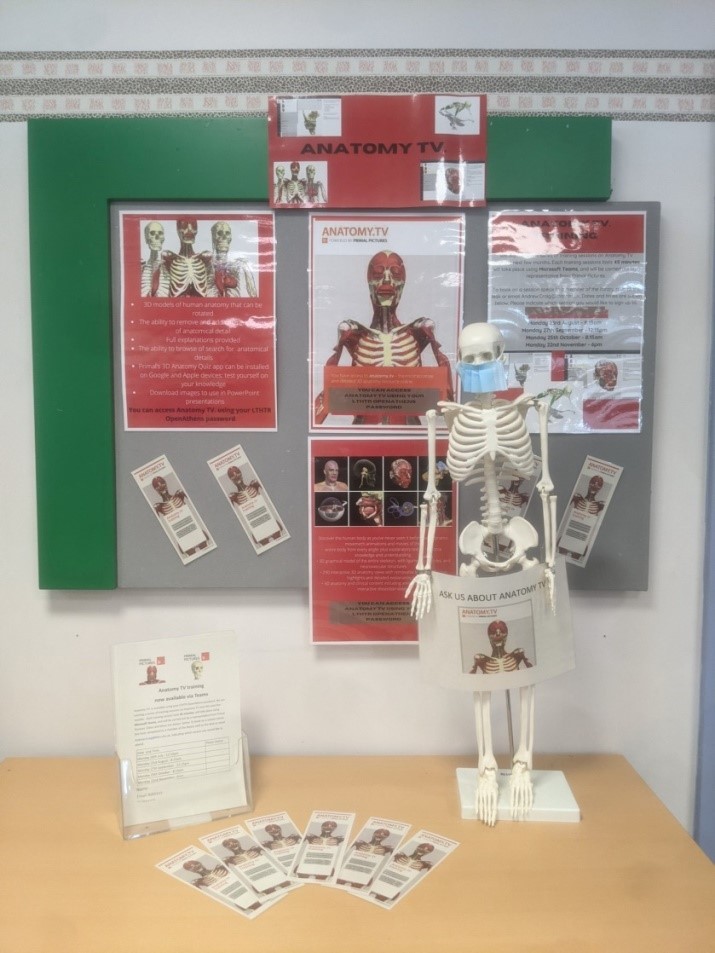
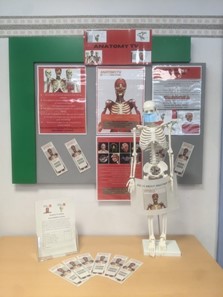
The Training
In previous years we have offered face-to-face training sessions when promoting our electronic resources, but this wasn’t appropriate during the pandemic due to social distancing measures. We were also aware that staff on the wards were very busy, and some students were still studying at home, so physically attending a session could be difficult for many. With this in mind, we decided to offer something different - online training via Microsoft Teams. MS Teams is a resource we have become very familiar with over the last year as a means of communicating with colleagues during the pandemic, but it was a new way of reaching our users, and a new way of delivering training.
We approached a Rep from Anatomy TV to find out if this would be something they could help us with, and luckily they agreed to get involved. To increase the chances of staff/students attending we decided to offer multiple dates, and at a range of different times during the day, i.e. morning sessions at 8:15am, lunch time sessions at 12:15pm, and an evening session at 6pm. We offered 1 session a month over a 5 month period between July and September. This would give plenty of opportunities for anyone interested in attending a session.
Once the dates/times were decided, we needed to start advertising. So we started with the Library website, social media, Library displays, Library screens, and our Library news bulletin / newsletters. We also emailed various departments we thought would be interested, like Physiotherapy, and specific staff groups, like Clinical Educators. We created a flyer which initially was displayed around the Library, but when new medical students arrived in September, it was put into their Library starter packs. This resulted in a large number of medical students signing up for the sessions. This was unusual compared to previous training we have offered, and we’re unsure if so many signed up because they wanted to, or because they thought it was compulsory. Prior to the sessions we sent out multiple reminders to those that had signed up with instructions on how to join on Teams.
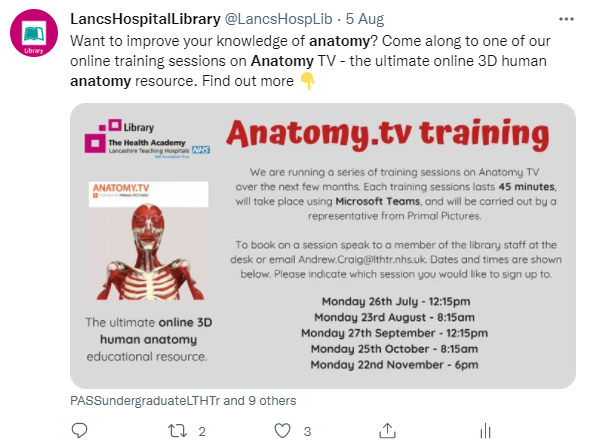
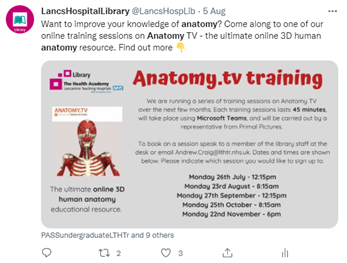
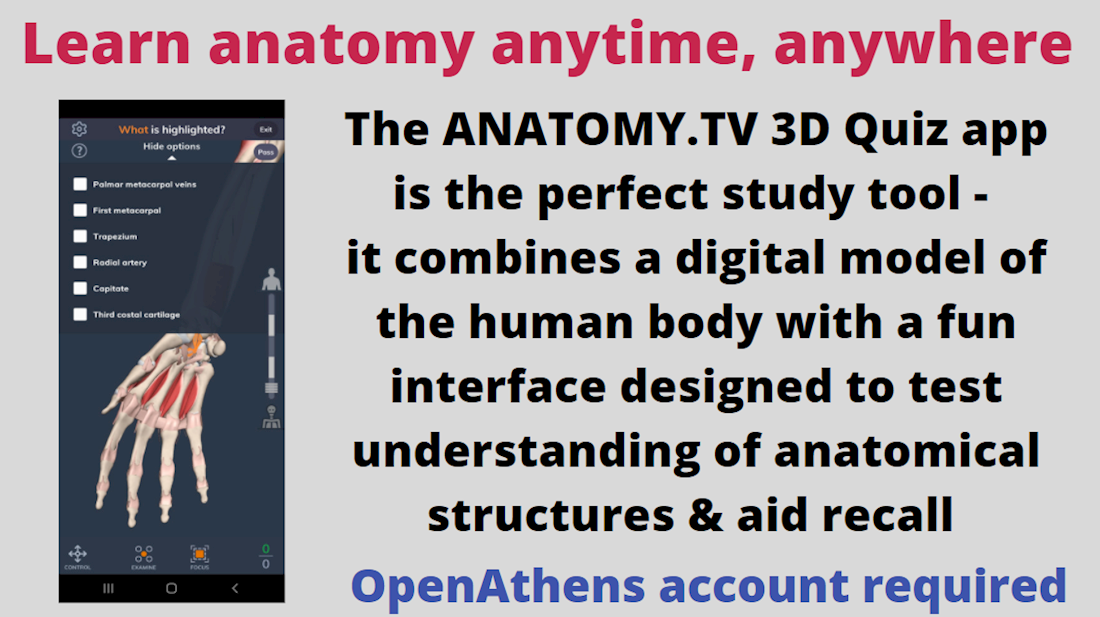
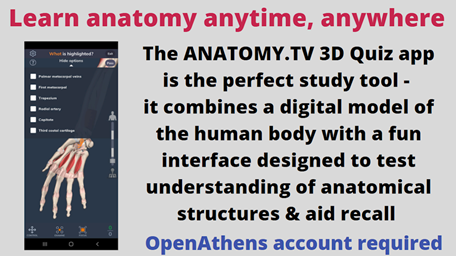
Unfortunately, although 123 originally signed up to attend, only 44 of those actually attended. This was largely because the medical students had been given their timetable for their placement with ward rounds and teaching they had to attend, and therefore were no longer available for the training. However, 44 was still a good attendance when compared with other training sessions we’ve run previously. Each session was 45 mins longs and was delivered in the main by the Anatomy TV rep. He provided a demonstration of all the main features of the resource, including how to download the Quiz App, and we also explained they would need to register for an Athens account. Following the session, all those that signed up, including those that couldn’t attend, were sent a recording of the session. This meant the medical students didn’t miss out and could watch the session at a later date.
To find out what the participants thought of the training, we sent a follow up survey. Unfortunately only 6 responded but the comments were positive, such as:
“Accurate and up to date anatomy will be used in teaching and the addition of animations and short videos will enhance the teaching experience.”
“It will be utilised whilst based within Hand Therapy to help with knowledge of hand anatomy and function.”
“It was a good session and very beneficial, I struggled to use Anatomy TV before this and definitely wasn't making the most of it. I didn't know the quiz section existed, it looks like it will really help my anatomy study.”
“It's useful to see how the muscles and bone interact. I'm a visual learner and I think it greatly helps my understanding.”
“It will greatly help us develop new courses that require anatomical images.”
Conclusions
Overall we were pleased with our marketing of this resource, but there is room for improvement. Statistics show that there have been 224 logins and 137 hours spent on the resource since we started our promotional work which is a good response. We had more success with the numbers attending training than any sessions we have ever offered before, despite the number of students who didn’t attend. Offering the training online via Teams definitely added to the success as people could attend where best suited them (at home, on the ward etc.) without having to physically attend the Library. It has opened up training to staff/students that may not have attended otherwise and we would continue this in future. Overall, the lunchtime session proved to be the most popular, so we would offer sessions at this time again. We hope to build on what we have learnt and are currently working on delivering our own Anatomy TV training sessions via Teams. In order to reach a wider audience next time, we would look at doing more tailored marketing to specific groups of staff or specific departments. Outreach activities such as distribution of the flyers around the hospital wards, information on screens around the hospital, attending events/meetings in the hospital, etc. would be beneficial. To ensure medical students can attend in the future, we could liaise with the undergraduate department to find out when the students have free time in their timetables to attend training and chose some dates specifically to suit them, and offer these dates in their Library starter packs. This would hopefully increase the total numbers attending sessions and reduce non-attendance.
Amy Belch BA(Hons) MA MCLIP
Assistant E-Resources Librarian
Library & Information Service
Lancashire Teaching Hospitals NHS Foundation Trust

